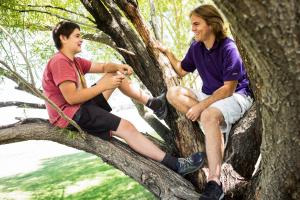Seven Stars RTC Introduces Brainspotting to Help Teens on the Spectrum Heal from Trauma
SYRACUSE, UTAH, UNITED STATES, December 2, 2020 /EINPresswire.com/ -- Seven Stars RTC, one of the nation’s premier residential treatment centers for teens with autism and other neurodevelopmental disorders, has introduced brainspotting to their clinical programming. Even though brainspotting is a fairly new treatment modality for trauma, initial studies have indicated similar outcomes when compared to EMDR therapy. Seven Stars therapists report that it has been a great addition to their therapeutic services, especially for students who benefit from a more somatic approach.
What is Brainspotting?
Brainspotting is a treatment that evolved out of EMDR therapy. It uses points in a client’s visual field as a tool for healing. “This treatment modality can provide relatively rapid change for trauma, depression, and anxiety,” says Dr. Gordon Day, Seven Stars RTC’s Founder and Executive Clinical Director. It is thought that Brainspotting helps clients access the deeper parts of their brain where traumatic memories are held. It is a creative way to engage teens with Autism Spectrum Disorder who often have a hard time with other more traditional ways of reprocessing trauma.
“What is interesting about brainspotting is that students can still work through a traumatic event even if they don’t have the language to describe it, which is common with teenagers on the Autism Spectrum,” says Rachelle Steed, LCSW, Primary Therapist at Seven Stars. “This is important because often the kids we work with struggle to find words to express how they are feeling. Structured techniques, like brainspotting, help them form new neural networks, which then helps them find prosocial ways to resolve the trauma or roadblocks they are facing.” By healing past traumatic events, brainspotting also helps students overcome the depression and anxiety associated with these events.
How is Brainspotting Practiced at Seven Stars RTC?
During a brainspotting session, Seven Stars RTC’s primary therapists help students access a “brainspot” (a point in visual space that a client has a strong reaction to) by either helping students identify where they feel memories in their body or by using reflexes depending on where they are looking. “When a brainspot is stimulated, the deep brain reflexively signals the therapist that the source of the trauma has been accessed,” says Rachelle Steed. “From there, we teach clients how to become more aware of their bodies and teach them grounding tools that are helpful to their healing.”
Brainspotting is particularly useful with teenagers, whose brains are naturally more neuroplastic and open to changes. Generally, teenagers on the Autism Spectrum struggle with rigid thinking, communication, and feeling “outside” their bodies. Seven Stars RTC has found brainspotting to be a useful tool to help teenagers with neurodiverse minds gain greater cognitive flexibility and heal from trauma. “We are very happy with the progress our students have made thanks to this new treatment modality and are excited to see upcoming research on the benefits of brainspotting for neurodiverse students,” says Dr. Day.

What is Brainspotting?
Brainspotting is a treatment that evolved out of EMDR therapy. It uses points in a client’s visual field as a tool for healing. “This treatment modality can provide relatively rapid change for trauma, depression, and anxiety,” says Dr. Gordon Day, Seven Stars RTC’s Founder and Executive Clinical Director. It is thought that Brainspotting helps clients access the deeper parts of their brain where traumatic memories are held. It is a creative way to engage teens with Autism Spectrum Disorder who often have a hard time with other more traditional ways of reprocessing trauma.
“What is interesting about brainspotting is that students can still work through a traumatic event even if they don’t have the language to describe it, which is common with teenagers on the Autism Spectrum,” says Rachelle Steed, LCSW, Primary Therapist at Seven Stars. “This is important because often the kids we work with struggle to find words to express how they are feeling. Structured techniques, like brainspotting, help them form new neural networks, which then helps them find prosocial ways to resolve the trauma or roadblocks they are facing.” By healing past traumatic events, brainspotting also helps students overcome the depression and anxiety associated with these events.
How is Brainspotting Practiced at Seven Stars RTC?
During a brainspotting session, Seven Stars RTC’s primary therapists help students access a “brainspot” (a point in visual space that a client has a strong reaction to) by either helping students identify where they feel memories in their body or by using reflexes depending on where they are looking. “When a brainspot is stimulated, the deep brain reflexively signals the therapist that the source of the trauma has been accessed,” says Rachelle Steed. “From there, we teach clients how to become more aware of their bodies and teach them grounding tools that are helpful to their healing.”
Brainspotting is particularly useful with teenagers, whose brains are naturally more neuroplastic and open to changes. Generally, teenagers on the Autism Spectrum struggle with rigid thinking, communication, and feeling “outside” their bodies. Seven Stars RTC has found brainspotting to be a useful tool to help teenagers with neurodiverse minds gain greater cognitive flexibility and heal from trauma. “We are very happy with the progress our students have made thanks to this new treatment modality and are excited to see upcoming research on the benefits of brainspotting for neurodiverse students,” says Dr. Day.
Dr. Gordon Day
Seven Stars RTC
+1 (844) 601-1167
email us here
Visit us on social media:
Facebook
Twitter
LinkedIn
Legal Disclaimer:
EIN Presswire provides this news content "as is" without warranty of any kind. We do not accept any responsibility or liability for the accuracy, content, images, videos, licenses, completeness, legality, or reliability of the information contained in this article. If you have any complaints or copyright issues related to this article, kindly contact the author above.

